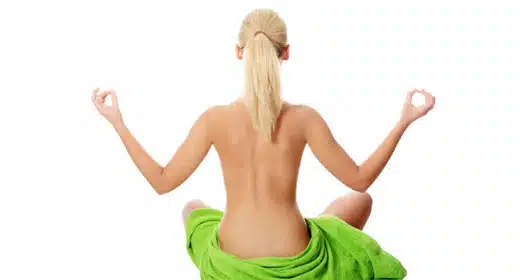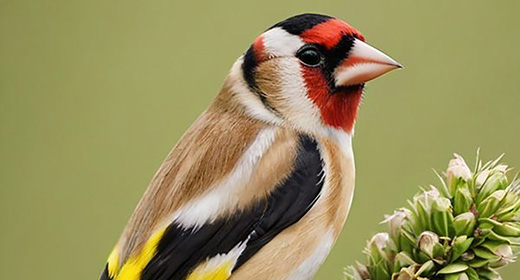The Root chakra is located at the base of the spine between the anus and genitals.
 Part of the practice of yoga is recognizing the chakras, which are a fundamental aspect of achieving inner peace and balance. Chakra is the Sanskrit word for ‘wheel’ and there are seven chakras arranged vertically in the body from the base of the spine to the top of the head. Chakras are thought of as spinning vortexes of energy that, when balanced, lead to higher consciousness and peace.
Part of the practice of yoga is recognizing the chakras, which are a fundamental aspect of achieving inner peace and balance. Chakra is the Sanskrit word for ‘wheel’ and there are seven chakras arranged vertically in the body from the base of the spine to the top of the head. Chakras are thought of as spinning vortexes of energy that, when balanced, lead to higher consciousness and peace.
The Root Chakra (Muladhara Chakra)
“I am.”
This chakra is located at the base of the spine between the anus and genitals. It is associated with physical identity, instinctual nature, survival, self-sufficiency, stability, and ambition. In Sanskrit, the root chakra is called Muladhara, with mula meaning ‘root’ and adhara meaning ‘support’. This chakra is symbolized by a square-shaped yellow lotus flower with eight shining spears on the sides and corners and four red petals. Within the yellow square is a red inverted triangle. According to Hindu belief, within the red triangle the kundalini shakti, or ‘great spiritual potential’ rests. It awaits arousal so that it may reunite with Brahman, or the source of divinity.
Each of the four petals represents the human tendencies: greatest joy, natural pleasure, delight in controlling passion, and blissfulness in concentration. They are also said to represent: dharma (psycho-spiritual longing), artha (psychic longing), kama (physical longing), and moksha (longing for spiritual liberation). These are all fundamentals of Hindu philosophy and religion.
The muladhara chakra is also the base from which three nadi (or energy channels) emerge: the Ida, Pingala, and Sushumna. These three channels flow up through the root chakra to the other six chakras and throughout the body.
Red is the color commonly associated with the muladhara chakra, and it is represented by the element of earth. It governs the anus, prostate, adrenals, kidneys, lower digestive functions, excretory functions, and sexual activity. When the root chakra is unbalanced or blocked, a person may experience tiredness, poor sleep, waste elimination problems (like constipation), depression, and obesity. This person may also feel ungrounded, afraid, alienated, possessive, or full of rage and anger. He or she may also be obsessed with comfort, have low self-esteem, and lack a sense of security.
Conversely, a balanced and open muladhara chakra leads to feeling grounded, centered, committed and independent, having energy and vitality, strength, and good digestion.
Asana for Muladhara
Here are three asana that will help you to open and balance the root chakra:
Mountain Pose (Tadasana)
This pose usually begins many other asana, and it is essential for grounding your feet and aligning your body. Giving attention to the root chakra’s proximity to other parts of the body, you can balance and open it. It also helps to build self-awareness for other poses.
How to do it: Stand with your big toes touching side by side, with your heels slightly apart. Balance your weight evenly on both feet. Imagine a line of energy flowing from your core up to the crown of your head (from the root to the crown chakra) and align your thighs, hips, and chest along that straight line of energy. Press your shoulder blades into your back and then release them. Lift your chest straight toward the ceiling and hang your arms beside your torso. Balance the crown of your head over the center of your pelvis (along that energy line) and gaze straight ahead, resting your tongue on the floor of your mouth. Stay in the pose for 30 seconds to a minute and breathe steadily.
Warrior I Pose (Virabhadrasana I)
This pose stretches the arms and shoulders and strengthens the legs and lower back. It was named for the mythic warrior Virabhadra and is invokes feelings of strength and power. This is a standing pose that grounds the root chakra, using your body’s natural flow of energy to stimulate it.
How to do it: Begin by standing up straight and then extending your left leg 1 to 1.5 meters behind you (depending on how long your legs are). Bend your knee so that it is directly above the ankle and a 90 degree angle is formed. With head, shoulders, and knees pointed forward and left foot turned in slightly, raise your arms above your head, palms facing one another and fingers pointed to the sky as you inhale. Look up at the ceiling. As you exhale, relax your shoulders and hold this position for 30 seconds to 1 minute. Lower your arms to your sides and bring your left leg slowly back in to reverse the position. Extend your right leg back and repeat the pose.
Standing Forward Bend (Uttanasana)
This pose is a feet grounding pose that helps to open the root chakra. It stretches and relieves tension in your entire back body, as well as massages and tones the abdominal organs. The Uttanasana also calms the brain and promotes circulation.
How to do it: Begin by standing with feet shoulder-width apart. Exhale and bend forward from your hips (not your waist). As you bend down, lengthen and stretch your torso. With your knees straight, place your hands on the floor beside your feet (or your hands to the backs of your ankles). Press your heels into the floor and lift your backside toward the ceiling. Let your head hang from the root of your neck, between the shoulder blades. When you inhale, lift and lengthen your torso. When you exhale, go slightly more forward in the bend. Hold the pose for 30 seconds to a minute. To come back up, bring your hands back to your hips and lift your entire torso back up when you inhale.









































